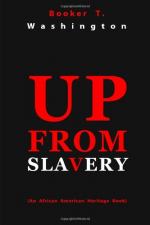The schoolhouse was some distance from the furnace, and as I had to work till nine o’clock, and the school opened at nine, I found myself in a difficulty. School would always be begun before I reached it, and sometimes my class had recited. To get around this difficulty I yielded to a temptation for which most people, I suppose, will condemn me; but since it is a fact, I might as well state it. I have great faith in the power and influence of facts. It is seldom that anything is permanently gained by holding back a fact. There was a large clock in a little office in the furnace. This clock, of course, all the hundred or more workmen depended upon to regulate their hours of beginning and ending the day’s work. I got the idea that the way for me to reach school on time was to move the clock hands from half-past eight up to the nine o’clock mark. This I found myself doing morning after morning, till the furnace “boss” discovered that something was wrong, and locked the clock in a case. I did not mean to inconvenience anybody. I simply meant to reach that schoolhouse in time.
When, however, I found myself at the school for the first time, I also found myself confronted with two other difficulties. In the first place, I found that all the other children wore hats or caps on their heads, and I had neither hat nor cap. In fact, I do not remember that up to the time of going to school I had ever worn any kind of covering upon my head, nor do I recall that either I or anybody else had even thought anything about the need of covering for my head. But, of course, when I saw how all the other boys were dressed, I began to feel quite uncomfortable. As usual, I put the case before my mother, and she explained to me that she had no money with which to buy a “store hat,” which was a rather new institution at that time among the members of my race and was considered quite the thing for young and old to own, but that she would find a way to help me out of the difficulty. She accordingly got two pieces of “homespun” (jeans) and sewed them together, and I was soon the proud possessor of my first cap.
The lesson that my mother taught me in this has always remained with me, and I have tried as best as I could to teach it to others. I have always felt proud, whenever I think of the incident, that my mother had strength of character enough not to be led into the temptation of seeming to be that which she was not—of trying to impress my schoolmates and others with the fact that she was able to buy me a “store hat” when she was not. I have always felt proud that she refused to go into debt for that which she did not have the money to pay for. Since that time I have owned many kinds of caps and hats, but never one of which I have felt so proud as of the cap made of the two pieces of cloth sewed together by my mother. I have noted the fact, but without satisfaction, I need not add, that several of the boys who began their careers with “store hats” and who were my schoolmates and used to join in the sport that was made of me because I had only a “homespun” cap, have ended their careers in the penitentiary, while others are not able now to buy any kind of hat.




